| To View Crop Details, click on the crop |
| Jawahar Rice |
Jawahar Soybean |
Jawahar Gram |
Jawahar Wheat |
|
Jawahar Maize |
Jawahar Pigeonpea |
Jawahar Millets
(Kutki, Kodo) |
Jawahar Pulses
(Urad, Mung, Lentil, Field pea) |
Jawahar Oilseeds
(Linseed, Sesame, Niger, Groundnut, Toria, Castor) |
Jawahar Fodder
(Berseem, Oat) |
Jawahar Barley and Jawahar Sugarcane |
Horticulture crops |
| Other varieties in Seed Production Chain
|
|
|
|
Gram or Chickpea (Cicer arietinum Linn.) is a major winter pulse crop grown in India. Among the pulses, chickpea occupies 30% of area with 38% of annual production in India. Chickpea is the pre dominant pulse crop in Madhya Pradesh.
JNAU has released 16 varieties of chickpea of Desi (JG 315, JG 74, JG 322, JG 11, JG 130, JG 16, JAKI 9218, JG 63, JG 412, JG 226 and JG 6), Kabuli (JGK 1, KGK 2, and JGK 3) and Gulabi types (JGG 1). These varieties are recommended for rainfed condition (JG 11, JG 130, JG 63, JG 226), partially irrigated (JG 315, JG 11, JG 218, JG 130, JG 16, JG 63) and late sown irrigated Kabuli JGK 1, JGK 2, JGK 3, Gulabi JGG 1) and some of early desi varieties are JG 14, JG 412, JG 11, JAKI 9218, JG 16) and Kabuli (JGK 1).
JNAU varieties are world wide donors for fusarium oxysporum, JG 315 (wilt resistant and insulation against 5 races), JG 62 for wilt susceptible check and JG 74 (wilt resistant and insulation against 2 races). The release of new varieties has changed the monoculture of JG 315 which enhanced the yield in the State of Madhya Pradesh and Maharastra. JG 11 brought the chickpea revolution in Andhra Pradesh by covering 70% area with potential yield of 36.0 q/ha by replacing age old wide adopted variety Annagiri. Medium bold seeded, wilt resistant Gulabi chickpea variety JGG 1 realized best for parching in Madhya Pradesh.
The varieties widely adopted by the farmers are JG 11, JG 130 and JG 16 having maximum national seed indent and varieties are covering more than 50% chickpea area in the country.
- JNAU varieties are covering 40% area of India
- JG 11 brought the chickpea revolution in A.P.
- JG 74, JG 130, JAKI 9218, JG 16, JG 63 have made diversification
- JG 14 identified as heat tolerant variety
- Introduction of Kabuli chickpea varieties led to expansion of 15% area

|
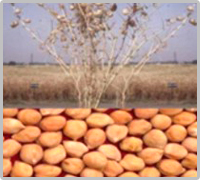
|
| JG 16: Maturity: 110-115 days, Seed size: 22-25 g, Seed yield: 18-20 q/ha, Semi spreading, profuse branching, dark green foliage, light brown, medium bold, attractive seed, rainfed |
JAKI 9218: Maturity: 112 day,s Seed size: 20-27 g, Seed yield: 18-20 q/h,a Semi spreading, porofuse branching, light brown bold seed, smooth surface, bold seed, better quality, resistant to lodging shattering, rainfed / irrigated conditions
|
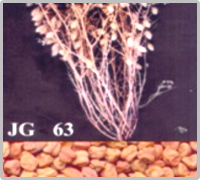
|
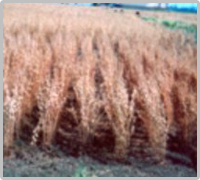
|
|
JG 63: Maturity: 110-115 days, Seed size: 17 ,g Seed yield: 20-25 q/ha, Semi spreading, profuse branching, medium bold, yellowish brown, wilt resistant, rainfed/ irrigated, wider adaptability
|
JG 14: Early (100-105 days), brown, medium bold seed High yielding Normal sown: 22-25 q/ha Late sown (18-19 q/ha), Plant type: Semi erect, R / MR to Wilt, DRR and Helicoverpa armigera, heat tolerant, Recommended under late sown conditions
|
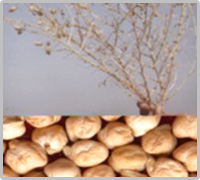 |
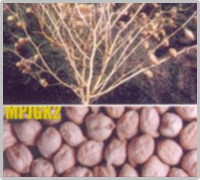 |
 |
|
JGK 1: Early, CVRC released |
JGK 2: Better cooking |
JGK 3: Extra bold |
|
Kabuli Chickpea : High yield: 18-19 q/ha, Maturity: Earliness 90-110 day,s Size: Medium to bold 45 g/100, Wilt resistant |
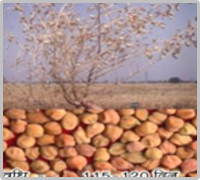 |
 |
 |
|
Gulabi Chickpea JGG 1: Maturity: 120-125 day,s Seed size: 13-15 g, Seed yield: 14-16 q/ha, Semi spreading, low anthocyanin pigmentation, white flower, light green foliage, thin pinkish smooth seed coat, medium round seed, pointed beak, resistant to wilt, good parching quality
|
|